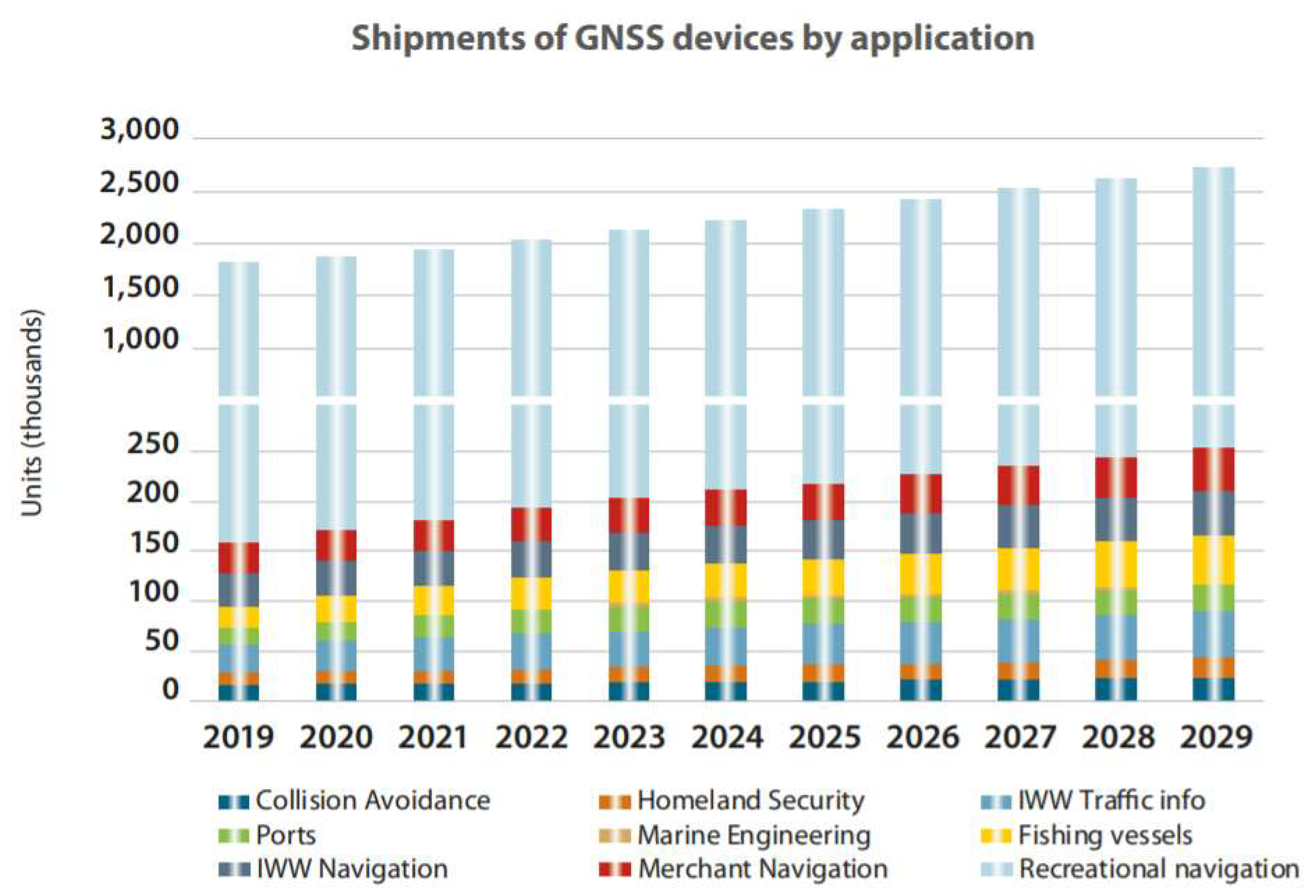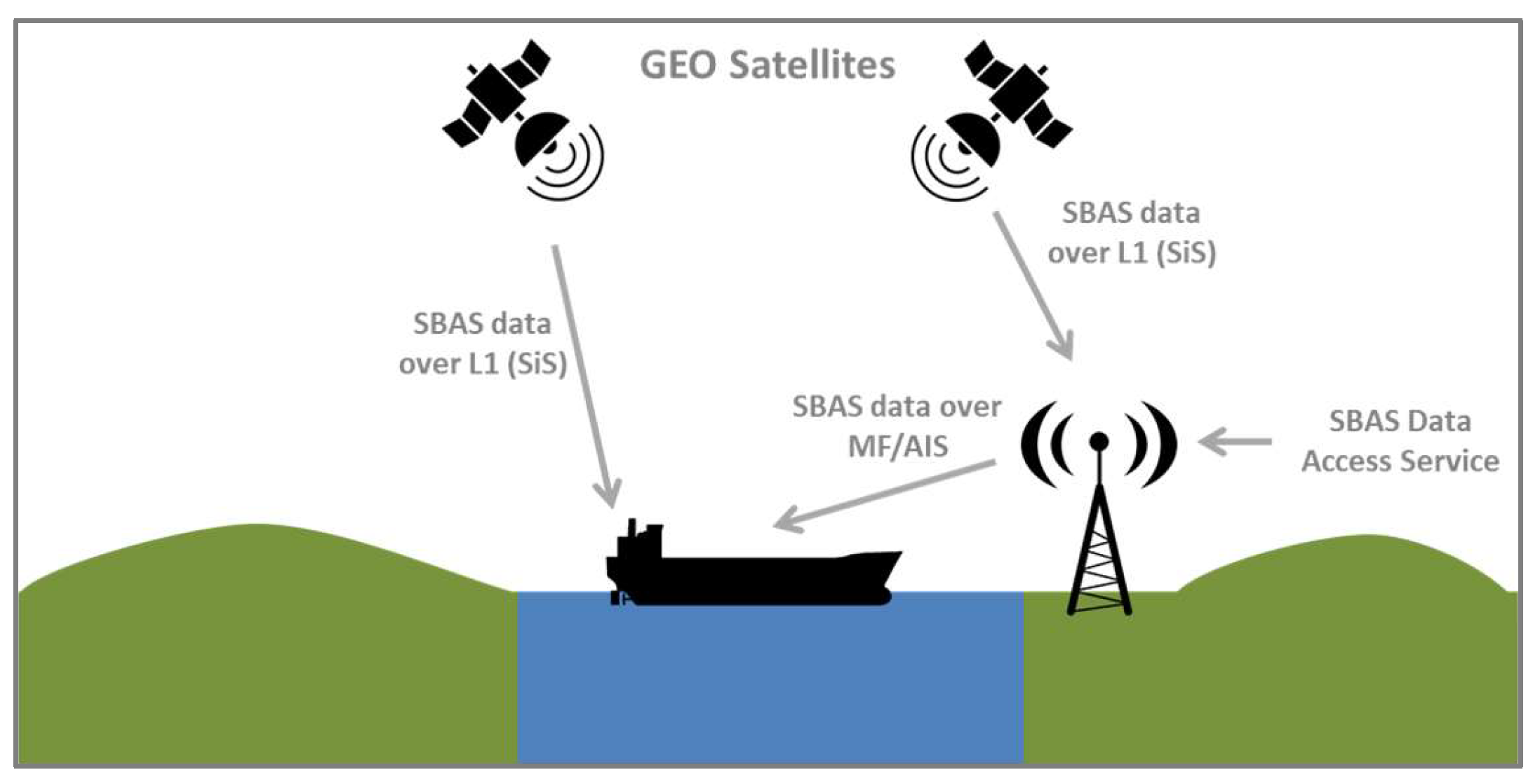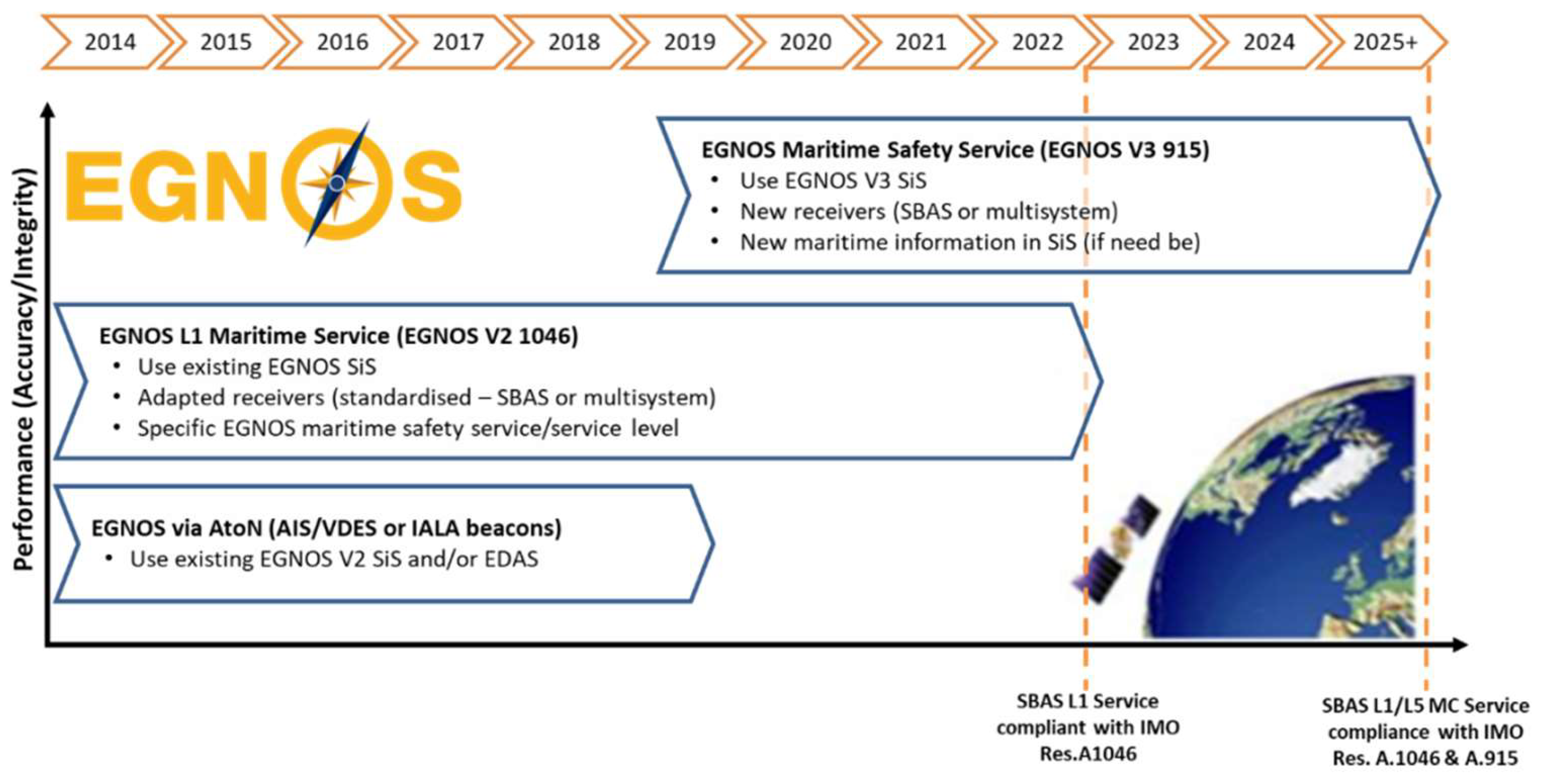SBAS/EGNOS for Maritime
Abstract
:1. Introduction
2. Satellite Based Augmentation Systems (SBAS)
3. SBAS in the Maritime Domain
- SBAS provides increased accuracy, availability and continuity in comparison with other navigation aids and in line with IMO resolution A.1046(27) [4] contributing to the safety of navigation;
- SBAS comply with common global standards and are compatible and interoperable, thus providing the user with a “seamless”, augmented, navigation solution in the regions where it is available, as depicted in Figure 2.
- SBAS services are available for free;
- SBAS services cover large areas including locations currently not served by other navigation aids. SBAS services are able to complement the coverage area of a DGNSS service to increase the availability and the continuity of the provision of correction data and integrity information;
- In some cases, SBAS may support the rationalization of ground-based navigation aids;
- In some cases (e.g., EGNOS Service Definition Documents), and in contrast to other GNSS services, it can be put in force the commitment between the AtoN providers or Maritime Authorities and the SBAS service provider establishing the terms conditions to guarantee the appropriate service level.
- Not Global SBAS coverage yet. The Northern Hemisphere is highly covered and the trend goes in the direction to cover the widest worldwide areas;
- Common GNSS vulnerabilities: interferences, jamming and spoofing.
4. SBAS/EGNOS for Maritime Navigation
4.1. SBAS/EGNOS Signal in Space (SiS)
4.2. SBAS/EGNOS Data Used via IALA MF Radiobeacons or AIS
- Phase 1: Transmission of EGNOS corrections over existing infrastructure (IALA DGPS beacons and AIS stations);
- Phase 2: The use of EGNOS v2 Signal in Space (L1—signal already available), a service aligned with IMO A.1046(27) [4];
5. SBAS/EGNOS Signal in Space Use
- IALA Guidance on Augmentation Systems—IALA ENG Committee has been working on guidance material with all the aspects that maritime or coastal administrations may take into account when considering the use of SBAS on ships in their waters. Two IALA Guidelines on the use of SBAS are available at the IALA website: IALA Guideline 1129 [8] focused on the retransmission of SBAS corrections using MF radio beacons and AIS stations, and (2) IALA Guidelines 1152 on the SBAS Maritime Service (SBAS SiS) [9].
- User and SBAS Receivers Standardization—The standardization activities are key to the provision of a SBAS Service in the maritime domain. The approach to the use of SBAS/EGNOS SiS for safe maritime navigation considers the reception of the L1 signal directly on-board the vessels with type approved receivers following a standardized implementation (type approved receivers according to the new standard to be developed. The development of a standard for SBAS on-board receivers is planned to be developed at IEC level (IEC TC80—maritime navigation and radio communication equipment and systems), where it is expected to agree with the corresponding Test Specification (in a working period of two years). Then, receiver manufacturers will be able to follow the IEC approved Test Specification to develop, build and type approve maritime SBAS user equipment.
- 3.
- Service Provision Scheme ([10] Section 6)—In order to guarantee an adequate level of SBAS service for the maritime users, a service provision scheme should be established, addressing at least:
- o
- Operation and maintenance;
- o
- Performance verification;
- o
- Publication of information (including the provision of EGNOS related maritime safety information).
- Reception of SiS on-board the vessels with type approved receivers (see (1) in the Figure 5).
- On the basis of the Service Definition Document (SDD) terms and conditions, the establishment of a potential working agreement between the ESP and the national competent authority (if requested by authority) laying down the technical modalities and required operational interfaces, for the delivery of this service (see (2) in Figure 5).
- Provision of EGNOS Maritime Safety Information (MSI) to the end users of the EGNOS L1 maritime service (see (3) (5) and (6) in Figure 5).
SBAS/EGNOS Maritime Safety Information (MSI)
6. SBAS Corrections Using MF-Radio Beacon and AIS
- Transmission of SBAS derived corrections over DGNSS stations (marine radio beacons);
- Transmission of SBAS derived corrections over AIS stations;
- Transmission of SBAS corrections over future VDES data channels.
7. Conclusions
Author Contributions
Funding
Conflicts of Interest
References
- IMO Circulars. SN.1/Circ.334, 20 May 2016. In Recognition of the Galileo Global Navigation Satellite System as a Component of the World-Wide Radionavigation System; International Maritime Organization: London, UK, 2016. [Google Scholar]
- IMO Circulars. SN.1/Circ.329, 21 November 2014. In Recognition of the Beidou Satellite Navigation System (BDS) as a Component of the World-Wide Radionavigation System; International Maritime Organization: London, UK, 2014. [Google Scholar]
- GSA GNSS Market Report Issue 6 2019. Available online: https://www.gsa.europa.eu/system/files/reports/market_report_issue_6_v2.pdf (accessed on 27 September 2020).
- IMO Resolution A.1046 (27) Worldwide Radionavigation System; Adopted on 30 November 2011; International Maritime Organization: London, UK, 2011.
- GSA GNSS User Technology Report Issue 2 2018. Available online: https://www.gsa.europa.eu/system/files/reports/gnss_user_tech_report_2018.pdf (accessed on 27 September 2020).
- EGNOS Data Access Service—Service Definition Document (EDAS SDD V2.2). Available online: https://www.gsc-europa.eu/sites/default/files/sites/all/files/egnos-data-access-service-sdd.PDF (accessed on 27 September 2020).
- IMO Resolution A.915 (22) Revised Maritime Policy and Requirements for a Future Global Navigation Satellite System (GNSS); Adopted on 29 November 2001; International Maritime Organization: London, UK, 2001.
- IALA Guideline 1129. Available online: https://www.iala-aism.org/product/g1129-retransmission-sbas-corrections-using-mf-radio-beacon-ais/ (accessed on 27 September 2020).
- IALA Guideline 1152. Available online: https://www.iala-aism.org/product/g1152-sbas-maritime-service/ (accessed on 27 September 2020).
- Support to Maritime and Inland Waterways Service Providers for the Transmission of EGNOS Corrections via IALA Beacons and AIS/VDES Stations. Available online: http://www.transnav.eu/Article_Support_to_Maritime_and_Inland_L%C3%B3pez,49,873.html (accessed on 8 July 2020).
- The European Maritime Radionavigation Forum—Website. Available online: https://emrf.eu/ (accessed on 27 September 2020).
- Joint IMO/IHO/WMO. Manual on Maritime Safety Information (MSI); International Maritime Organization: London, UK, 2015. [Google Scholar]
- EGNOS Bulletin Issue 30, Q2 2019. Available online: https://egnos-user-support.essp-sas.eu/new_egnos_ops/news-events/egnos-bulletin (accessed on 8 July 2020).




| Ocean Waters | Harbor Entrances, Harbor Approaches and Coastal Waters | |
|---|---|---|
| Horizontal Accuracy 95% | 100 m | 10 m |
| Signal availability | 99.8% | 99.8% |
| Service continuity (over 15 min) | - | 99.97% |
| Position update rate | 2 s | 2 s |
| Time to Alarm 1 | MSI as soon as practicable | 10 s |
| System coverage | Adequate 2 | Adequate 2 |
© 2020 by the authors. Licensee MDPI, Basel, Switzerland. This article is an open access article distributed under the terms and conditions of the Creative Commons Attribution (CC BY) license (http://creativecommons.org/licenses/by/4.0/).
Share and Cite
Lopez-Martinez, M.; Álvarez, J.-M.; Lorenzo, J.-M.; Daroca, C.G. SBAS/EGNOS for Maritime. J. Mar. Sci. Eng. 2020, 8, 764. https://doi.org/10.3390/jmse8100764
Lopez-Martinez M, Álvarez J-M, Lorenzo J-M, Daroca CG. SBAS/EGNOS for Maritime. Journal of Marine Science and Engineering. 2020; 8(10):764. https://doi.org/10.3390/jmse8100764
Chicago/Turabian StyleLopez-Martinez, Manuel, José-Manuel Álvarez, José-Maria Lorenzo, and Carlos Garcia Daroca. 2020. "SBAS/EGNOS for Maritime" Journal of Marine Science and Engineering 8, no. 10: 764. https://doi.org/10.3390/jmse8100764
APA StyleLopez-Martinez, M., Álvarez, J.-M., Lorenzo, J.-M., & Daroca, C. G. (2020). SBAS/EGNOS for Maritime. Journal of Marine Science and Engineering, 8(10), 764. https://doi.org/10.3390/jmse8100764





